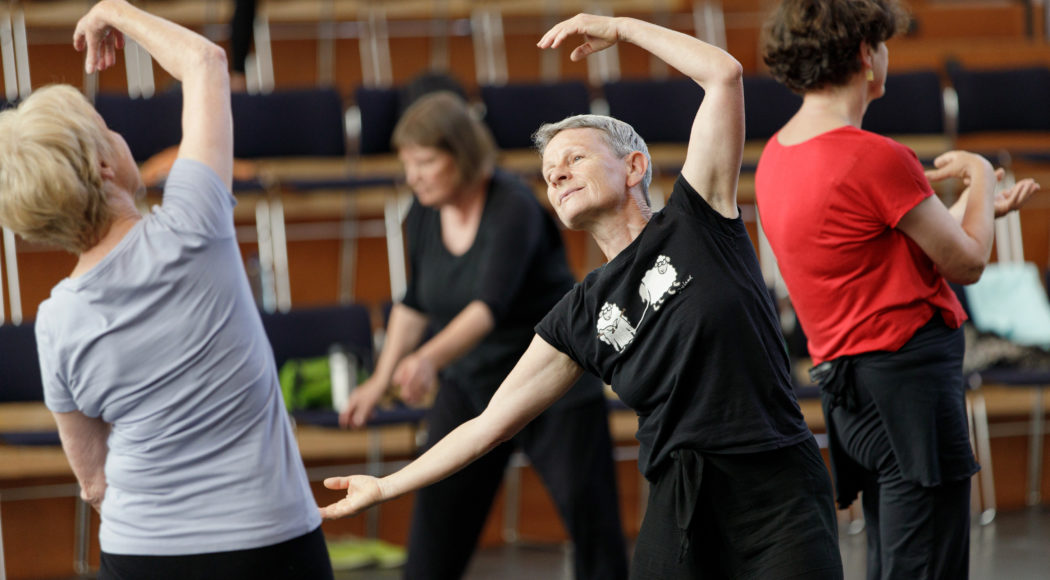„I would not have thought that I could still do that“, #2 – 2020
At ArtRose people over 60 years meet regularly to move and improvise together. Moritz Kotzerke, Head of Audience Development, Cultural Education and Networks in HELLERAU spoke with the initiator Jenny Coogan, Professor at the Palucca University of Dance.
Ms. Coogan, who or what is ArtRose?
ArtRose was born in January 2011. My mother just turned 80 and I wanted to give her a very special gift. As a dancer, choreographer and director of my own company I thought: Why not develop a dance piece with people who are close to her age? And so I approached a few acquaintances whose outward expression interested me. From this, a group was formed and in May 2012 we performed our first piece in HELLERAU. The group has some special features: Firstly, it is not about dancing skills. Most participants* have very little experience with dance. Most of them came to dance as pensioners. Secondly, the group has been in existence continuously without interruption since 2011 (six of the original ten people are still in the group today). And thirdly: I as a choreographer do not develop a ready-made dramaturgy, but the ideas arise from the weekly practice of the group. This also leads to a strong authenticity on stage, and the movement forms we work with are very diverse.
How can one concretely imagine a meeting of the ArtRoses in HELLERAU?
We have been meeting once a month in HELLERAU for about three years now. In the beginning it was always the solid core and it took a while until new people from Dresden joined us. I think the special thing about it is that people feel accepted and come to a room where everyone gets the recognition of everyone. The trainings are structured in a way that we start with small warm-up exercises. For example, we try to move with our hands and our breath like jellyfish and find forms for it. This sometimes goes so far that one has the feeling that the breath is striving from the inside out through the skin and is being pulled back again. These exercises for arriving and warming up are also done with professional dancers*, they might just be taken differently, because everyone does it differently. There are a lot of small group or partner exercises, it is about getting into contact – not through skin contact, but through the perception of exploring the space together. Thus, we mobilize, knead, explore levels, alone or with others. But never with a really given material to learn. There are tasks or ideas and then we find answers together in longer improvisations.
You have known the participants* for quite a long time now. Can you describe what these experiences with dance mean to the participants and what they learn there?
I think the atmosphere and the space to try things out very much support their own imagination and self-efficacy. Some people told me after a few years that they had great problems with self-criticism and were afraid of embarrassment. ArtRose has helped them to get rid of these fears. With others it is more about physical abilities. Many then think, “Wow, I didn’t think I could do that anymore.” And that doesn’t mean that you are incredibly virtuoso, but they feel their abilities of artistic expression through dance. Because even walking can be a dance if it is full of intention, expression, poetry. One of them is a professor*at the university and she said that she is no longer afraid of her lectures with 400 people.
Do you think that the participants of ArtRose see and perceive contemporary dance differently?
Many people say that their understanding of contemporary dance has developed greatly through ArtRose. They look at a greater variety of dance and find better ways to approach it for themselves. If you broaden your artistic view as a spectator*, then the possibility arises to open your own perceptive faculty and find access to different forms. The special thing about ArtRose HELLERAU is that the group is led mainly by the guest artists* who perform in HELLERAU. The meetings are usually only one hour before the performance begins, and then the pieces can usually still be experienced on stage. It makes the visit more communal, because you have already shared something with others before, and you might go to the restaurant or garden together before the performance. That way you get in contact with others and have exchange. For me, this is a much more complete experience of dance. Not only in the role of the spectators.
How would ArtRose in HELLERAU develop if you were allowed to dream? And is there anything you would like to give us as a house?
Of course I would love it if we could perform with ArtRose in HELLERAU again. There are always special events with different groups, but there has never been a festival for older people. Our society consists to a large extent of older people and at that age they have so much experience and artistic expression in their bodies. To me, old means: What a material! What experiences! Everything in a physical body. And I believe that there is an audience for that as well. Many of our performances are well attended. Many older people enjoy watching them. Personally, I see it as a social benefit when older dance ensembles not only do something in senior* homes or common rooms, but also become more visible in the rooms where art is shown.


